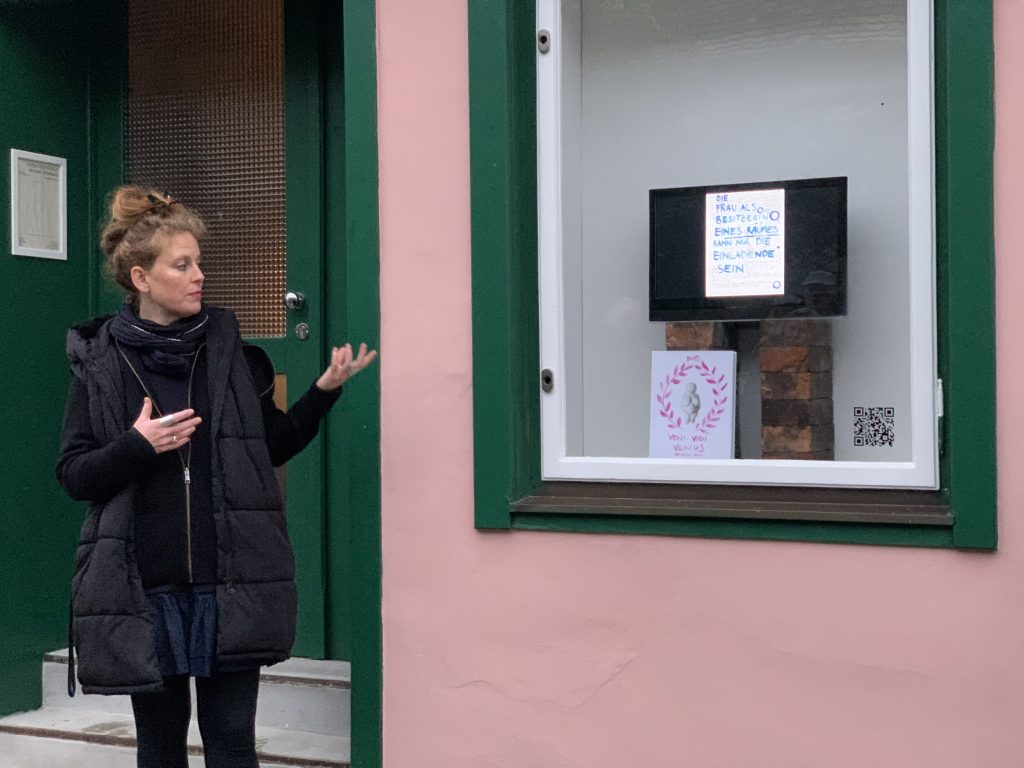Ida-Marie Corell - VENI VIDI VENUS on tour: Retzbach
2024

Ausstellungskonzept:
Gestaltung, Inhalt
Ida-Marie Corell
Umsetzung
Ida-Marie Corell
Brigitta Schmidt-Lauber
Norbert Dietler
Unterstützung
Erich Landsteiner
Oskar Schmidt-Lauber
Die Ausstellung VENI VIDI VENUS der Künstlerin Ida-Marie Corell reflektiert Fragen weiblicher Spiritualität und die „weibliche Position in der Frage des Seins“, wie Ida im vorbereitenden Gespräch erklärte. Ein Bildschirm im Schaukasten zeigt nacheinander die Seiten ihres gleichnamigen Buches VENI VIDI VENUS, die die künstlerische Auseinandersetzung mit dem Thema als Zeichnungen, Collagen und Texte zeigen.
Nicht zufällig lehnt sich der Titel an den Ausspruch des römischen Staatsmannes und Feldherrn Gaius Julius Caesar über seinen Blitzsieg in der Schlacht bei Zela „Veni, vidi, vici“ (ich kam, ich sah, ich siegte) an, der Ausdruck männlicher Durchsetzungsmacht ist. Das bekannte Sprichwort deutet die Künstlerin weiblich um, wobei die Venus von Willendorf als Symbol für Weiblichkeit, Erdverbundenheit und Matriarchat steht. Die künstlerische Thematisierung folgt einer binären Logik, die patriarchale Muster, die gesellschaftliches Leben maßgeblich prägen, matriarchalen Strukturen gegenüberstellt.
Die mit vielfältigen Ausdrucksformen arbeitende Künstlerin – Ida arbeitet sowohl mit Performances, Installationen, Musik, Zeichnungen, Text, Collagen, Malerei, Fotografie, Film und Videos – studierte an der Universität für Angewandte Kunst in Wien und veröffentlichte 2011 ihre am Zentrum für Kunst und Wissenstransfer verfasste Dissertation „Alltagsobjekt Plastiktüte“. In zahlreichen Ausstellungen, Performances und Beiträgen widmete sie sich der Plastikwelt. Nur scheinbar stellt die künstlerische Hinwendung zur Venus von Willendorf sowie zu existenziellen Fragen weiblicher Identität einen thematischen Bruch dar. Für Ida hingegen handelt es sich um eine folgerichtige Entwicklung, in der dem männlich konnotierten Plastik erdbezogene weibliche Themen gegenübergestellt werden. „Das Plastikzeitalter konnte sich nur im Patriarchat entwickeln“, lautet ihre These.
Ein großes Thema ihres künstlerischen Schaffens wie auch ihres subjektiven Erlebens ist die Synästhesie – ein Wahrnehmungsmodus, der durch Verflechtung verschiedener Sinnesbereiche entsteht und Eindrücke von Farben und Temperatur, Ton, Musik oder räumlichen Konstellationen verknüpft.
Die entstandene Venus-Kunst versteht Ida-Marie Corell mit Joseph Beuys als soziale Plastik bzw. Skulptur. Damit artikulierte Beuys den Anspruch der gesellschaftsverändernden Rolle von Kunst, womit die Wirkmacht von Kunst nicht länger auf ihre formalästhetisch materielle Dimension reduziert ist, sondern menschliches Handeln einbindet und so die Strukturierung und Formung von Gesellschaft mitdenkt. So sind auch die Venus-Arbeiten Ida-Marie Corells eine sich fortlaufend weiterentwickelnde Skulptur, die in „Venusischen Salons“, Vorträgen, Talks und anderen Events erweitert wird. Aktuell befindet sich die Künstlerin mit ihrer Arbeit auf Tournee, gastierte zunächst in New York, nun Retzbach, bald Berlin, Kreta und anderen Orten.
Ein Kennzeichen ihres künstlerischen Schaffens ist auch die musikalische Ausdrucksform: Ida-Marie Corell schreibt Lieder und veranstaltet musikalische Performances wie etwa die „Primordial Ocean Night“ am Heiligen Stein Mitterretzbach. Auch zur Eröffnung der VENI VIDI VENUS-Ausstellung im SchauFenster präsentierte Ida-Marie Corell im Stadl selbst geschriebene Lieder, die während ihrer Forschung zur Venus entstanden sind, mit thematischem Bezug zur Ausstellung. Dazu begleitete sie sich mit der Gitarre, während im Hintergrund die Buchseiten ihrer Venus-Kunst zu sehen waren.
Brigitta Schmidt-Lauber
English:
The exhibition VENI VIDI VENUS by artist Ida-Marie Corell reflects questions of female spirituality and the “female position in the question of being”, as Ida explained in the preparatory talk. A screen in the showcase displays the pages of her book of the same name, VENI VIDI VENUS, one after the other, showing her artistic exploration of the theme in the form of drawings, collages and texts.
It is no coincidence that the title is based on the saying of the Roman statesman and general Gaius Julius Caesar about his lightning victory in the Battle of Zela “Veni, vidi, vici” (I came, I saw, I conquered), which is an expression of male assertiveness. The artist reinterprets the well-known proverb in female terms, with the Venus of Willendorf symbolising femininity, earthiness and matriarchy. The forms of expression follow a binary logic that juxtaposes patriarchal patterns, which significantly shape social life, with matriarchal structures.
The artist, who works with diverse forms of expression – Ida works with performances, installations, music, drawings, text, collages, painting, photography, film and videos – studied at the University of Applied Arts in Vienna and published her dissertation “Alltagsobjekt Plastiktüte”, written at the Center for Art and Knowledge Transfer, in 2011. She has devoted herself to the world of plastic in numerous exhibitions, performances and contributions. The artistic focus on the Venus of Willendorf and existential questions of female identity only seem to represent a thematic break. For Ida, however, it was a logical development in which earth-related female themes were juxtaposed with plastic with its male connotations. “The age of plastic could only develop within patriarchy,” is her thesis.
A major theme of her artistic work as well as her subjective experience is synaesthesia – a mode of perception that arises through the interweaving of different sensory areas and combines impressions of colors and temperature, sound, music or spatial constellations.
Ida-Marie Corell, together with Joseph Beuys, understands the resulting Venus art as social sculpture. Beuys thus articulated the claim of the socially transformative role of art, whereby the impact of art is no longer reduced to its formal-aesthetic material dimension, but rather incorporates human action and thus also considers the structuring and shaping of society. Ida-Marie Corell’s Venus works are thus also a continuously evolving sculpture that is expanded in “Venusian Salons”, lectures, talks and other events. The artist is currently on tour with her work, first in New York, now in Retzbach, soon in Berlin, Crete and other places.
A characteristic of her artistic work is also the musical form of expression: Ida writes songs and organises musical performances, such as at the Primordial Ocean Night at at the Holy Stone Mitterretzbach. At the opening of the VENI VIDI VENUS exhibition in the SchauFenster, Ida-Marie Corell also presented songs she had written herself in the Stadl, which were created during her research on Venus with a thematic reference to the exhibition, to which she accompanied herself on the guitar, while the pages of her Venus art book could be seen in the background.
Brigitta Schmidt-Lauber
Ida-Marie Corell


